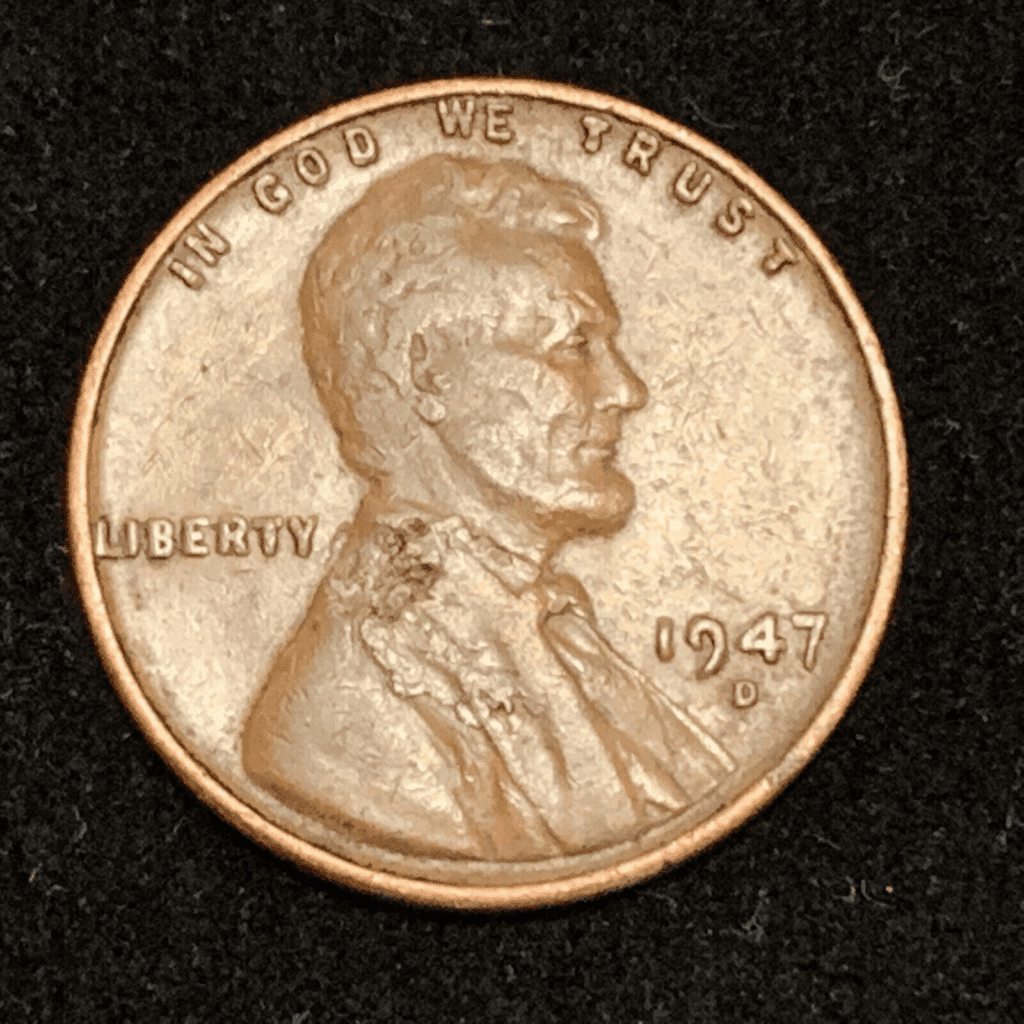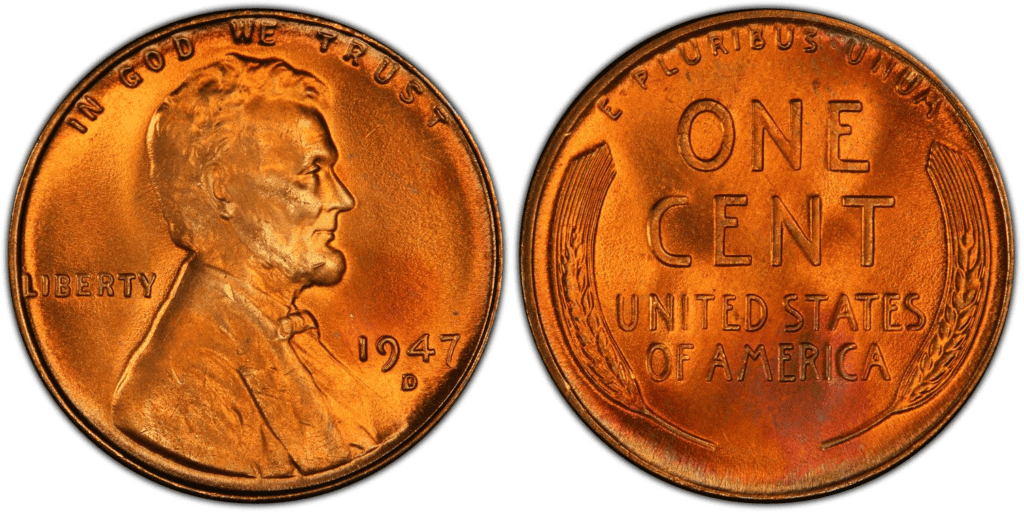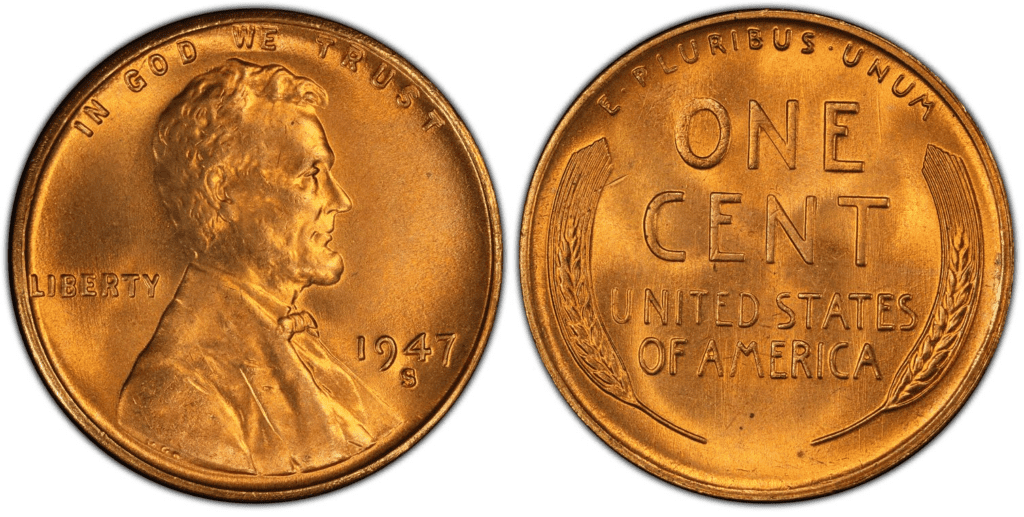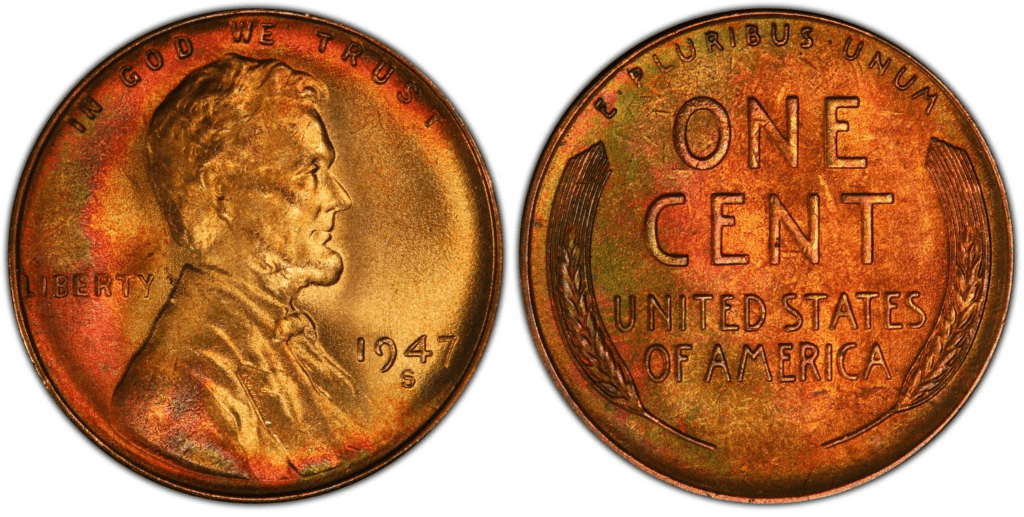What Is the 1947 Lincoln Penny Made Of?
The Lincoln penny is considered by many the most popular coins in the US. The US Mint has struck it for more than a century; thus, you can understand why the Lincoln penny has already been part of the country’s history.
The 1947 Lincoln penny is just one of the many coin series of the Lincoln penny. It comprises 95% copper and 5% tin and zinc. From 1909 to 1944, except for 1943, the Lincoln penny was always made with this composition. In 1943, the penny was made with zinc-plated steel. From 1982 to this day, the Lincoln penny was made with 97.5% zinc and 2.5% copper.
The Lincoln penny was first struck in 1909. Victor David Brenner designed both the reverse and the obverse sides of the coin.

The obverse features the image of Abraham Lincoln facing to the right. Inscriptions include the following:
- In God We Trust
- Liberty
- 1947
The Lincoln penny was first struck in 1909. Coincidentally, it is also the same year of the centennial year of Lincoln’s birth.
The reverse features two stalks of wheat. Inscriptions include the following:
- One Cent
- United States America
- Pluribus Unum
The wheat on the penny symbolizes diligence, prosperity, and hard work. It was a perfect choice to include in a coin that most people can easily get. The wheat design was changed into the Lincoln Memorial design in 1959.
1947 Lincoln Penny Varieties
The US Mint has produced the 1947 Lincoln penny through its three main mint centers, which are located in Denver, Philadelphia, and San Francisco. The varieties of 1947 primarily differ in where they are struck, and their mint marks mainly differentiate them. However, the 1947 pennies from Philadelphia don’t have any mint marks.
The 1947 varieties are called 1947-D, 1947-P, and 1947-S. The mint also produced error coins during minting. Each mint center produced a different number of Lincoln pennies. Here’s a breakdown:
| Variety | Location | Mintage |
| 1947-D Lincoln Penny | Denver | 194,750,000 |
| 1947-P Lincoln Penny | Philadelphia | 190,555,000 |
| 1947-S Lincoln Penny | San Francisco | 99,000,000 |
| Total | 484,305,000 |
Overall, the U.S. Mint produced more than 484 million pennies of the combined varieties of the 1947 wheat penny and released these coins into circulation. While this might look like a huge number, it is actually lower than the mintage of pennies in 1946 and 1948.
Aside from the varieties, there are also three types of 1947 pennies, which are based on their color. These types are brown, red and brown, and red wheat pennies. Generally speaking, the redder the color of the penny, the higher its value.
To learn more about these varieties of the 1947 Lincoln wheat penny, take a look at the descriptions below:
1947 D Lincoln Penny
Edge: Plain
Mint Mark: D
Place of minting: Denver
Year of minting: 1947
Face Value: $0.01 (one cent)
Price: $10 to $16 (or more)
Quantity produced: 194,750,000
Designer: Victor David Brenner
Composition: 95% Copper and 5% Tin and Zinc
Mass: 3.11 grams
Diameter: 19.05 mm

photo source: PCGS
The Denver mint produced the most 1947 pennies, striking over 1947 million coins. Although it has already been decades since these pennies were struck, you should be able to find them in circulation and collection hubs easily.
There are even more than 1,100 examples of MS66RD-graded 1947-D pennies today. However, MS67RD-graded pennies are rare, with just over 60 certified examples. MS68 to MS70 pennies are the rarest.
Depending on their condition, you can buy or sell 1947-D pennies starting from $10 to $16.
1947 P Lincoln Penny
Edge: Plain
Mint Mark: No mintmark
Place of minting: Philadelphia
Year of minting: 1947
Face Value: $0.01 (one cent)
Price: $8 to $36 (or more)
Quantity produced: 190,555,000
Designer: Victor David Brenner
Composition: 95% Copper and 5% Tin and Zinc
Mass: 3.11 grams
Diameter: 19.05 mm

photo source: PCGS
The Philadelphia Mint produced 190 million 1947-P pennies. The pennies from this mint center don’t have mintmarks. The price starts at around $8 to $36.
Although there are millions of 1947-P pennies, it isn’t easy to find in top grades. The reason is that these pennies often have streaking and spotting, which significantly lowers their grade.
1947 S Lincoln Wheat Penny
Edge: Plain
Mint Mark: S
Place of minting: San Francisco
Year of minting: 1947
Face Value: $0.01 (one cent)
Price: $7 to $27 (or more)
Quantity produced: 99,000,000
Designer: Victor David Brenner
Composition: 95% Copper and 5% Tin and Zinc
Mass: 3.11 grams
Diameter: 19.05 mm

photo source: PCGS
The San Francisco Mint produced 99 million pennies in 1947. This is quite low compared to the previous year, when the mint produced more than 198 million pennies.
This significant decrease is due to the economic recession and the recently concluded war. This led to lower demand for pennies.
In 1947 and the following years, the San Francisco Mint, along with other mint centers, was put under a tight budget. As a result, the die used for the 1947-S penny was used until they were visibly worn out.
When this happened, the Mint needed to polish the die heavily. The coins that were then hit by the newly polished die become so beautiful that they look like proof coins. However, the die would eventually be worn out again and result in not-so-detailed coins.
Thus, today, you will find 1947-S pennies with bright luster but eroded elements all over their surface. 1947-S pennies may be worth around $7 to $27.
List Of 1947 Lincoln Penny Errors
As mentioned above, more than 484 million pennies were issued in 1947. You can just imagine that this huge mintage inevitably leads to some coins being produced with errors.
Some of the most common penny errors include the following:
- Planchet error – this happens when the planchet is incorrectly produced. For example, some planchets were clipped or folded. There are also those that were cut too thin or too thick.
- Lamination error – the penny’s surface looks peeled or flaked due to the lamination error. This happens when the planchet’s composition is mixed with impurities. Since the foreign material doesn’t mix well with the rest of the metal, it separates itself upon cooling down the metal.

- Die break error – the die was heavily used in 1947. Because of wear and tear, the die may break. The break caused a crack in the die. When the die strikes the planchet, the die leaves a crack mark on the coin. Die break error may manifest as a small or thin hairline on the coin’s surface.
Although error coins look weird or ugly, these coins are actually valuable in the eyes of collectors. After all, error coins are unique and interestingly different. You’ll find some expensive 1947 pennies to be coins with errors.
How Much Is the 1947 Lincoln Penny Worth Today?
The 1947 Lincoln penny has a face value of 1 cent. Its melt value is $0.0252. There’s no doubt that the 1947 penny isn’t that valuable if you’re just going to look at its face value or melt value.
Regardless, the true value of the 1947 Lincoln penny lies in its perceived value. Remember that this coin is really old, and finding these coins today may be difficult, especially if you’re looking for coins that are still in good condition.
To see the value of the 1947 Lincoln penny, take a look at this values chart:
| Coin | Condition | Grade | Mintage | Value |
| 1947 D Lincoln penny | Circulated/mint | Not graded | 194,750,000 | $0.20 to $0.40 |
| 1947 D Lincoln penny | Uncirculated/mint | MS-65 | 194,750,000 | $6 to $16 |
| 1947 D Lincoln penny | Uncirculated/mint | MS-66 | 194,750,000 | $22 to $69 |
| 1947 D Lincoln penny | Uncirculated/mint | MS-67 | 194,750,000 | $109 to 456 |
| 1947 P Lincoln penny | Circulated/mint | Not graded | 190,555,000 | $0.20 to $0.40 |
| 1947 P Lincoln penny | Uncirculated/mint | MS-65 | 190,555,000 | $7 to $138 |
| 1947 P Lincoln penny | Uncirculated/mint | MS-66 | 190,555,000 | $59 to $441 |
| 1947 P Lincoln penny | Uncirculated/mint | MS-67 | 190,555,000 | $480 to $2,280 |
| 1947 S Lincoln penny | Circulated/mint | Not graded | 99,000,000 | $0.20 to $0.50
|
| 1947 S Lincoln penny | Uncirculated/mint | MS-65 | 99,000,000 | $7 to $264 |
| 1947 S Lincoln penny | Uncirculated/mint | MS-66 | 99,000,000 | $20 to $65 |
| 1947 S Lincoln penny | Uncirculated/mint | MS-67 | 99,000,000 | $140 to $264 |
As you can see, the 1947 penny can be super valuable. If it is in the right condition and rare, then you can be confident that it will be more valuable than its face value.
To truly appreciate the value of the 1947 penny, here are the auction records for each variety:
- $9,200 – a 1947 1C, RD (Regular Strike) coin with a grade of MS67 sold in March 2012 by Stack’s Bowers
- $5,250 – a 1947-S 1C, RD (Regular Strike) coin with a grade of MS67 sold in June 2013 by David Lawrence RC
- $1,920 – a 1947-D 1C, RD (Regular Strike) coin with a grade of MS67+RD sold in August 2020 by Stack’s Bowers
How Does The Grading System Work?
The Sheldon Scale is used by numismatists to provide a numerical value to coins. The Sheldon Scale goes from poor (P-1) to perfect mint state (P-1) (MS-70). Coins were originally evaluated using words to reflect their condition (Good, Fair, Excellent, Etc.). Unfortunately, coin collectors and dealers had different ideas about what each of these terms represent.
Professional numismatists joined together in the 1970s and established CoinGrading standards. These numismatists now assign grades at key places on the seventy-point scale, using the most regularly utilized numeric points in conjunction with the original adjective grade. The following are the most common coin grades:
-
-
- (P-1) Poor – Indistinguishable and probably damaged; if used, must have a date and mintmark; otherwise, rather battered.
- (FR-2) Fair – Nearly smooth, but without the damage that a coin graded Poor often possesses. The coin must have enough detail to be identified.
- (G-4) Fair – Inscriptions have merged into the rims in some areas, and important elements have been mostly erased.
- (VG-8) Very Good- A little weathered, but all of the primary design elements are visible, albeit faintly. There is little if any, central detail left.
- (F-12) Good – The item is very worn, yet the wear is even, and the overall design details stand out clearly. Rims are almost completely isolated from the field.
- (VF-20) Very Fine – Moderately weathered, with some finer features still visible. The motto or all letters of LIBERTY are readable. Both sides of the coin have entire rims that are separated from the field.
- (EF-40) Extremely Fine – Gently used; all gadgets are visible, and the most important ones are bold. The finer details are bold and clear, however, light wear may be seen.
- (AU-50) Uncirculated – Slight evidence of wear on the coin’s design’s high points; may have contact marks; eye appeal should be adequate.
- (AU-58) Uncirculated Choice – Slight traces of wear, no severe contact marks, almost full mint shine, and great eye appeal.
- (MS-60) Mint State Basal – Strictly uncirculated; no indication of wear on the coin’s highest points, but an unsightly coin with reduced luster, visible contact marks, hairlines, and other flaws.
- (MS-63) Mint State Acceptable – Uncirculated, but with contact scratches and nicks, little reduced shine, but otherwise appealing appearance. The strike is weak to average.
- (MS-65) Mint State Choice – Uncirculated with great mint shine, very little contact blemishes, and exceptional eye appeal. The strike is unusually severe.
- (MS-68) Mint State Premium Quality – Uncirculated with superb luster, no obvious contact marks to the naked eye, and exceptional eye appeal. The strike is quick and appealing.
- (MS-69) Almost Perfect Mint State – Uncirculated with perfect brilliance, a sharp and appealing strike, and extremely good eye appeal. A near-perfect coin with minor imperfections in the planchet, strike, and contact markings (seen only under 8x magnification).
- (MS-70) Mint State Perfect – Under 8x magnification, there are no tiny imperfections discernible; the strike is crisp, and the coin is perfectly centered on a beautiful planchet. Rarely seen on a coin, this coin is bright and whole, with original luster and exceptional eye appeal.
-
Where To Buy Or Sell 1947 Lincoln Penny?
Whether you plan to sell or buy a 1947 Lincoln penny, you will be happy that the Internet is here. There are hundreds of websites today that specialize in selling and buying coins. These include USA Coin Book, CoinTracker, Grey Sheet, and JM Bullion.
Some marketplaces popularly buy and sell coins. These include eBay and Amazon. Occasionally, you’ll find these coins on social media platforms like Facebook Marketplace.
If you don’t find what you need on the Internet, you can visit coin shops, pawnshops, and even antique stores. You can also join auctions, which are known to have some of the rarest coins you could ever find.
FAQs
Is a 1947 D penny rare?
Circulated 1947 D pennies are not rare. There are still millions of them in existence. However, a 1947 penny becomes rare if it is in Mint State condition. 1947 pennies with a grade of at least MS67 are considered rare.
How much is a 1947 steel penny worth?
The 1947 penny is made of copper, tin, and zinc. The only series of pennies made with steel is the 1943 issue. There’s no recorded 1947 steel penny. So, if you ever find one, that would be extremely rare, and the value could reach up to thousands or even a million dollars.
Is a 1947 copper penny worth anything?
As its face value indicates, the 1947 copper penny is worth 1 cent. Nevertheless, if you have a rare 1947 copper penny, which is still in good condition, the value could reach $1,00 to $1,000.



